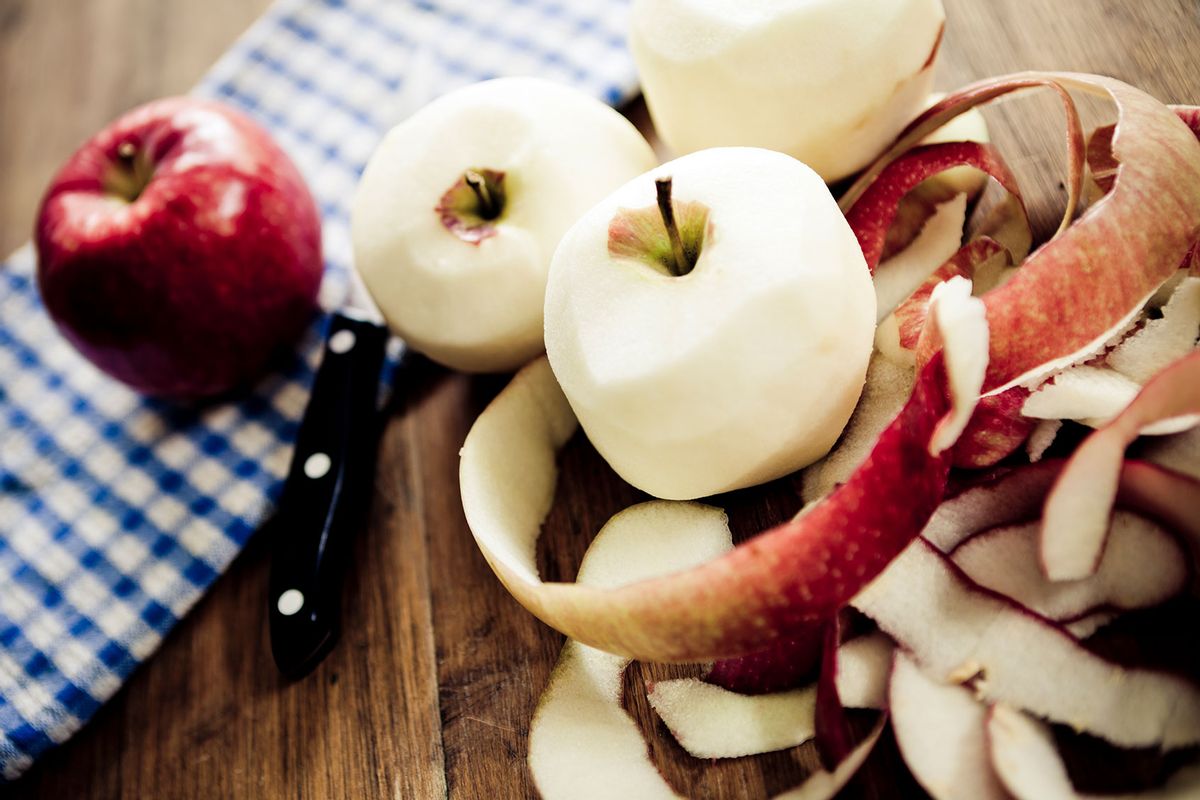Apples may be the quintessential harbinger of autumn, even more so than the falling leaves, the welcome chill in the air or the ubiquitous PSL. From apple picking escapades and fresh-out-of-the-oven apple pies to warm apple cider and the crisp snap of a bite of a freshly picked apple, the humble fruit perfectly encapsulates both the seasonality and sentimentality of fall.
While some trudge home from apple picking with a five-pound bag and a list of all the amazing things to do with your new surplus, some snag an apple or two and then leave the bag to sit, the ethyl circulating, the apples browning and collapsing under themselves. Instead of allowing these autumnal gems to go to waste, utilize them in all of their shades, variations, and flavor profiles: baked goods, ciders, juices, savory applications, jams, apple butters, donuts, cocktails, specialty deserts, and so much more.
It's imperative to note, though, that one byproduct of heavy apple cookery is a heap of leftover peels and skins. Unless leaving the skin on when making apple pie or nonchalantly munching on an unpeeled apple, the skin itself is rarely consumed. But why? It's packed with nutrients and vitamins, it's totally edible, and the varying colors make quite an interesting tapestry, indicative of the shifting shades of autumn.
Looking to minimize food waste, use up the whole apple (sans seeds and stem, of course), and appreciate applies with a new fervor this fall? Read ahead for some tips:
Dehydrated ("chips") and/or ground
If you're fortunate enough to have a dehydrator on hand, then load it up with apple peels! Otherwise, turn your oven to its lowest setting and cook the apple peels until they are crisp and seemingly devoid of their moisture.
Bonus: you can enjoy the dehydrated "chips" as-is, or you can crush them in a coffee grinder, food processor or by hand, and then use as a dried apple seasoning of sorts. Leave as-is if you're looking to use it in savory applications (apple-seasoned roasted vegetables, apple-seasoned sautéed chicken, etc.), or mix with some cinnamon and sugar for a delicious sprinkle for coffees, breakfasts, desserts, yogurts and so much more.
Potpourri
While obviously (unfortunately?) not edible, leftover apple peels are a perfect foundation for a DIY potpourri. Essentially a mix of dried fruits and seasonings along with particular scented oils, potpourri is an amazing vehicle to utilize those otherwise-discarded apple peels. Conversely, if you have a ton of apples leftover, you can even thinly slice them, roast or dehydrate them, and use the whole apple slices in the potpourri, too. Mix along with dried orange, cinnamon, cranberries, cloves, extracts, spices, and oils. You'll be thrilled with the autumnal aromas permeating your home.
Peels for Pets
If your pup is experiencing some gastrointestinal issues, many vets recommend a "clean diet" consisting of white rice and boiled chicken. Some also recommend pumpkin. If you have a heaping pile of apple peels on your counter, though, slip some into their food for a boost of fiber that your pet will also probably love. Win-win!
Tea
Steep some apple peels in boiling water — flavoring as you wish with additional seasonings or sweeteners — and curl up with a big mug and enjoy. The subtle apple flavor makes this a stellar morning beverage, especially if it's also steeped with some cinnamon sticks.
Use in salads
Think about carrot peels or super-thinly sliced fennel and the texture and flavor they lend to salads. While using apple peels might seem odd, they are a great addition in that same vein. If you find that the "raw" peel is flaccid or unappetizing in the salad, feel free to roast before adding, or dehydrate fully, if you find that that crisp crunch is an alluring texture in your salad.
Apple Cider Vinegar
One of the health world's favorite items, ACV has become one of the most in-demand supplements — as well as a handy, all-purpose tool to have around the house. While it was once a mere salad dressing vinegar, it's now sold in pill form and other forms, becoming part of some daily regimens along with other vitamins and minerals. This process, however, is quite involved and can take up to months to complete. This is also due to the fact that ACV is a fermented product. Of course, though, the health benefits of ACV outweigh the laborious and time-consuming process. Also, you need nothing more than apple peels, water, sugar, and canning jars or bottles.
Apple syrup
Arguably the most delicious item on this list, this apple syrup offers a rich, autumnal flavor that will elevate anything its added to. Essentially a reduction of maple syrup or brown sugar, apple peels, and water, this syrup is not as viscous as maple but not as thin as simple syrup. You can also enrich it even further with cream, honey, or butter. Use in coffees, yogurts, in homemade granola, over breakfast items like pancakes or waffles, or mix it with butter and slather it on anything your heart desires.
Agrodolce
Essentially an Italian "sweet-and-sour sauce," agrodolce is a perfect balance of the two taste sensations. Oftentimes combining a sweetener or a fruit with an acid, the sauce or condiment can be customized in many ways. Here, the sweet component comes from the apple sweetness, which is balanced by a sharp vinegar, such as sherry or red wine. Many also add honey and golden raisins, along with fresh herbs, and while some agrodolces are thin and loose, others are thick and jammy. Regardless, they're all incredibly flavorful.
Hopefully this gives you some ideas for what to do with your apple surplus and the ensuing pile of peels.
Read more
about this topic
Salon Food writes about stuff we think you'll like. While our editorial team independently selected these products, Salon has affiliate partnerships, so making a purchase through our links may earn us a commission.



Shares